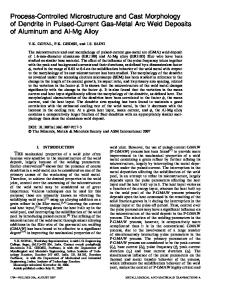Characterization of microstructure and mechanical properties of continuous and pulsed current gas tungsten arc welded su
- PDF / 3,166,535 Bytes
- 20 Pages / 584.957 x 782.986 pts Page_size
- 46 Downloads / 411 Views
The present study investigates the joining of 5-mm-thick plates of superaustenitic stainless steel, AISI 904L by continuous current (CC) and pulsed current (PC) gas tungsten arc welding (GTAW) using ER2553 and ERNiCrMo-4 fillers. This research article attempts to provide a detailed structure–property relationship of these weldments. Interface microstructure revealed the absence of deleterious secondary phases at the heat affected zone in all the cases. Skeletal delta ferrite morphology at the cap of ER2553 fusion zone and multidirectional grain growth at the ERNiCrMo-4 fusion zone were observed for both the weldments. The average hardness at the fusion zone was found to be higher for PCGTA weldments using ER2553 due to the higher proportions of ferrite. Tensile studies corroborated that the failure occurred at the parent metal in all the cases. Charpy V-notch studies divulged that the CCGTA and PCGTA weldments utilizing ERNiCrMo-4 filler exhibited the greater impact toughness of 69 J and 75 J, respectively. The bend test results conveyed that both the CCGTA and PCGTA weldments using ERNiCrMo-4 exhibited soundness and ductility. I. INTRODUCTION
Superaustenitic stainless steel (SASS), AISI 904L, an alloy of Fe–Cr–Mo contains higher amounts of nickel compared to the conventional austenitic grades. SASS also exhibits excellent corrosion resistance and hightemperature strength, which puts them at the forefront of metallurgical technology. These materials have received recent attention from the U.S. Navy for their use in the new fleet of Advanced Double Hull (ADH) combatant ships.1 The presence of high molybdenum content along with the increased levels of chromium and nitrogen gives this stainless steel grade excellent resistance to pitting, crevice, and chloride stress corrosion cracking.2 The addition of nitrogen, along with enhancing the mechanical properties of these steels, is also useful in delaying and/or even preventing the formation of harmful precipitates. These steels have improved mechanical properties such as weldability and formability compared to the conventional stainless steels and Ni-based superalloys. Researchers have reported that SASS exhibits superior impact toughness and can maintain their impact properties even at low subzero temperatures, adjudging them as best candidate material for cryogenic applications.3–5
Contributing Editor: Jürgen Eckert a) Address all correspondence to this author. e-mail: [email protected] DOI: 10.1557/jmr.2015.111 J. Mater. Res., 2015
http://journals.cambridge.org
Downloaded: 04 May 2015
Koutsoukis et al.6 investigated the aging characteristics of two different superaustenitic steel grades. The samples of these steel grades were exposed to isothermal heat treatment in the temperature range of 650–950 °C for aging between 0.5 and 3000 h, followed by quenching in water to room temperature. The authors reported the formation of secondary phases, including sigma phase (r), chi phase (v), Laves phase, and b-Cr 2 N phase during the heat treatment. Also, they claimed that there
Data Loading...











